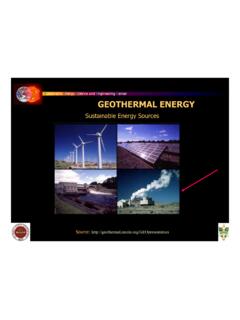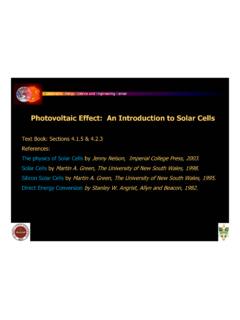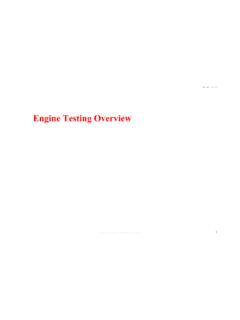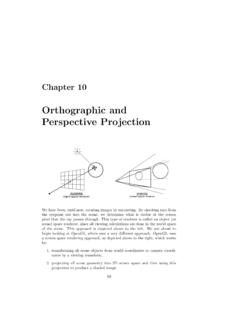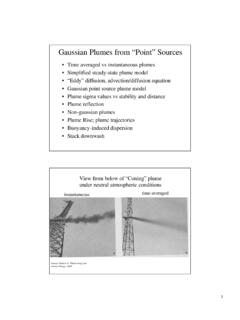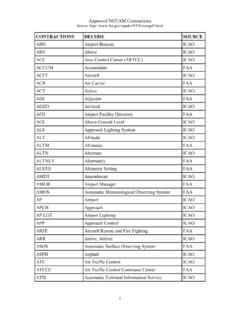Transcription of Thermodynamics Fundamentals for Energy Conversion …
1 SustainableEnergyScience andEngineeringCenterThermodynamics Fundamentals for Energy Conversion Systems Renewable Energy Applications The study of the laws that govern the Conversion of Energy from one form to the otherSustainableEnergyScience andEngineeringCenterEnergy ConversionConcerned with the transformation of Energy from sources such as fossil fuel and radiation from Sun into conveniently used forms such as electrical Energy , propulsive Energy , heating and cooling. Forms of Energy : Kinetic, potential, thermal, chemical, electromagnetic is the study which seeks to establish quantitative relationships among macroscopic variables (like pressure, temperature, molecular concentrations etc.) which describe an arbitrary physical system (system being very large compared with atomic dimensions) in an equilibrium state.
2 FuelAirProducts of combustionWaste heat to cooling towerElectrical Energy (Work)~Objective: Convert the availability of the fuel into work in the most efficient manner, taking into consideration cost, size, safety and environmental plantSustainableEnergyScience andEngineeringCenterEnergy Sources and Conversion ProcessesSustainableEnergyScience andEngineeringCenterEnergy Conversion TechnologiesSustainableEnergyScience andEngineeringCenterLaws of ThermodynamicsThe Zeroth Law of Thermodynamics :If two systems are in thermal equilibrium with a third, then they are in thermal equilibrium with each other. This law is the basis of temperature measurement. First Law of Thermodynamics : The change in internal Energy of a closed system is equals to the heat added to the system (or absorbed from the environment) minus the work done by the system (or on the environment).
3 This law is a consequence of conservation of Energy . While attempting to transform heat into work with full efficacy, we quickly learned that always some heat would escape into the surrounding environment as wasted Energy (recall that Energy can not be destroyed). This wasted Energy can never be fully converted into anything useful. Second Law of Thermodynamics : It is impossible to construct an engine which, operating in a cycle, will produce no other effect than the extraction of heat from a single heat reservoir and the performance of an equal amount of work. It imposes a limitation on Energy transformations other than that imposed by the first law. SustainableEnergyScience andEngineeringCenterThe second law states that heat flows naturally from regions of higher temperature to regions of lower temperature, but that it will not flow naturally the other way.
4 Heat can be made to flow from a colder region to a hotter region, which is exactly what happens in an air conditioner, but heat only does this when it is forced. On the other hand, heat flows from hot to cold spontaneously. Entropy is an indicator of the temperature of Energy . A given amount of thermal Energy has low entropy when it is at high temperature, and the same amount of Energy has higher entropy when it is at lower is Energy , and with Energy , size matters. With temperature, it does radiant Energy that arrives at Earth from the Sun at a temperature of 6000 K is a very low-entropy form of heat. EntropySustainableEnergyScience andEngineeringCenterA power cycle receives heat at a high temperature, converts some of this Energy into mechanical work, and rejects reminder at a lower temperature. By virtue of second law of Thermodynamics , no powercycle can convert more heat into work than the Carnotcycle.
5 The theoretical maximum efficiency of any heat engine is defined by the Carnot Cycle. The Carnot cycle is a hypothetical engine involving four processes: an adiabatic reversible compression and expansion and a constant temperature heat addition and rejection. The Carnot heat engine (the ideal heat engine) has an efficiencyequal to (TH-TC)/TH where TH is the temperature of the hot source and TC is the temperature of the cold sink. Thermal Efficiency thermal=1 TcTHSustainableEnergyScience andEngineeringCenter1. Reversible isothermal expansion of the gas at the "hot" temperature, this step, the expanding gas causes the piston to do workon the surroundings. The gas expansion is driven by absorption of heat from the high temperature reservoir. adiabatic expansion of the this step we assume the piston and cylinder are thermally insulated, so that no heat is gained or lost.
6 The gas continues to expand, doing work on the surroundings. The gas expansion causes it to cool to the "cold" temperature, TC. isothermal compression of the gas at the "cold" temperature, the surroundings do work on the gas, causing heat to flow out of the gas to the low temperature reservoir. adiabatic compression of the again we assume the piston and cylinder are thermally insulated. During this step, the surroundings do work on the gas, compressing it and causing the temperature to rise to TH. At this point the gas is in the same state as at the start of step 1. The Carnot CycleSustainableEnergyScience andEngineeringCenterThe amount of work produced by the Carnot cycle, wc, is the difference between the heat absorbed in step 1, qHand the heat rejected in step 3,qC. Or in equation form: (1)The efficiency of a heat engine is defined as the ratio of the work done on the surroundings to the heat input at the higher temperature.
7 Thus for the Carnot cycle:(2)It can also be shown that for the Carnot cycleqC/qH= TC/TH, so in terms of temperature, the efficiency is: (3) From Equation 3 it is clear that in order to maximize efficiency one should maximize THand minimize qC =wcqH=qH qCqH=1 qCqH =1 TCTHThe Carnot CycleSustainableEnergyScience andEngineeringCenterThe Carnot CycleCarnot's theorem states that No engine operating between two heat reservoirs can be more efficient than a Carnot engine operating between the same , Equation 3 gives the maximum efficiency possible for any engine using the corresponding temperatures. A corollary to Carnot's theorem states that: All reversible engines operating between the same heat reservoirs are equally Equation 3 gives the efficiency of any reversible engine. In reality it is not practical to build a thermodynamically reversible engine, so real heat engines are less efficient than indicated by Equation 3.
8 Nevertheless, Equation 3 is extremely useful for determining the maximum efficiencythat could ever be expected for a given set of thermal more useful question to ask is : what is the efficiency when the engine is working at maximum power? A simple analysis will give maximum power=1 TcTHSustainableEnergyScience andEngineeringCenterThe gasses used inside a Stirling engine never leave the engine. There are no exhaust valves that vent high-pressure gasses, as in a gasoline or diesel engine, and there are no explosions taking place. Because of this, Stirling engines are very Stirling cycle uses an external heat source, which could be anything from gasoline to solar Energy to the heat produced by decaying plants. No combustion takes place inside the cylinders of the engine. The key principle of a Stirling engine is that a fixed amount of a gas is sealed inside the engine.
9 The Stirling cycle involves a series of events that change the pressure of the gas inside the engine, causing it to do work. There are several properties of gasses that are critical to the operation of Stirling engines: If you have a fixed amount of gas in a fixed volume of space and you raise the temperature of that gas, the pressure will increase. If you have a fixed amount of gas and you compress it (decrease the volume of its space), the temperature of that gas will increase. Stirling EngineStirling-cycle engines are among the most efficient practical heat-engines ever built. SustainableEnergyScience andEngineeringCenterThe simplified engine uses two cylinders. One cylinder is heated by an external heat source, and the other is cooled by an external cooling source. The gas chambers of the two cylinders are connected, and the pistons are connected to each other mechanically by a linkage that determines how they will move in relation to one EngineALPHA-TYPE STIRLING ENGINES ustainableEnergyScience andEngineeringCenterGamma type Stirling EngineBeta type Stirling EngineRef: G.
10 Walker., Stirling Engines, (1980), Oxford Univ. EngineSustainableEnergyScience andEngineeringCenterRegenerator: Acts as a thermal barrier between the hot and cold ends of the machine and also store some of the thermal Energy . Usually consists of a mesh material and heat is transferred as the working gas is blown through the regeneration mesh. Heat is either deposited or withdrawn from the regenerator depending on the direction the gas is moving. Thermodynamic Processes in configurationSustainableEnergyScience andEngineeringCenterThermodynamic Processes in an Ideal Stirling Cycle12: Isothermal (Constant Temperature) expansion23: Constant volume displacement34: Isothermal compression45: Constant volume displacementSustainableEnergyScience andEngineeringCenterEfficiency of an Ideal Stirling CycleW= mRlnV2V1 TH TL()The equation for work (represents Energy out of the system) : For isothermal expansion process, the heat input is given by:The efficiency is defined by: QH=mRTHlnV2V1 = WQH=TH TL()TH= carnotSustainableEnergyScience andEngineeringCenter1.

